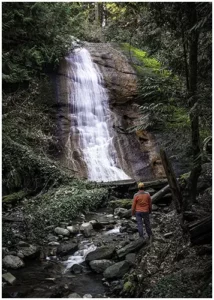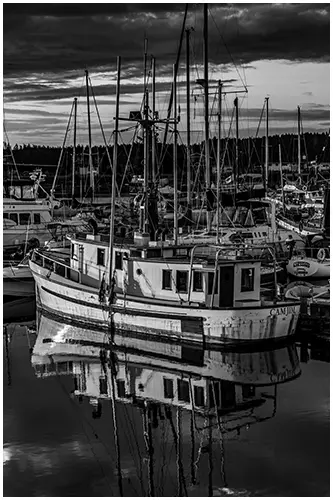
The Charming Northfield Falls in the Heart of Beach Estate Park
Looking to kill off an hour while in Nanaimo, BC? Just a short hop-skip and


Contrast is a powerful tool in a photographer’s arsenal. In photography, understanding saturation and its impact on a contrast photo is a critical skill. Saturation enhances photos by adding depth and dimension, softening intense colours when used with low contrast techniques. Photographers can create contrast and enhance a photo’s mood, making it more captivating by mindful use of saturation and colour sliders. Numerous photography tutorials are available that explain the detailed nuances of applying different types of contrast and saturation effectively.
Contrast in photography refers to the difference in brightness between the darkest and brightest areas of an image, specifically highlighting the different types of contrast between shadows and highlights. Understanding contrast in photography can enhance the drama and mood of your shots. It involves tone, colour, and texture. Contrast in photography goes beyond just light and shadows. It is supported by colour theory and is essential knowledge for photographers.
Contrast creates visual intrigue and appeal in your contrast photos, enabling your images to tell captivating stories. Moreover, elements like aperture assume a crucial role in managing various forms of contrast. Adjusting settings like aperture and depth of field can help to create contrast, transforming a plain background into a smooth, blurred effect. Understanding and using contrast with the right camera settings can greatly improve your photography. You will obtain superior results and elevate your skills to new levels by applying this knowledge of the diverse types of contrast in photography.
The interplay of light and shadow is crucial to achieving different types of contrast. An example includes silhouette photography, which involves a play of light and shadows. Position subject between camera and bright light source, like the setting sun, to capture solid dark silhouette on bright background. Bright, directional light, like sunlight, leads to high contrast images with deep shadows and bright spots.
Conversely, diffused light on cloudy days produces a lower contrast image with softer highlights and less pronounced shadows. Understanding the effect of light and shadow is crucial in photography. It helps manage the contrast and achieve different tones in your photos. The distance between objects in the photo and their distance from light sources determines the contrasts.
Colour contrast plays a significant role in impacting an image’s perception. By employing techniques of colour contrast photography, you can evoke depth and elicit emotions in your images. Tonal and colour contrasts separate the elements of a composition, giving your shots an enchanting quality. Using different colours, especially warm ones like red, yellow, and purple, and cool ones like blue and gray, creates distinct yet balanced visual narratives. Further, understanding the colour wheel allows you to effectively maneuver colour contrast.
Get the best out of complementary colour contrast by experimenting with pairs like purple and yellow, and blues and orange. Using software like Luminar Neo can help you adjust the colour contrast in your photos. It allows you to experiment with different levels of intensity for colour contrast. Ultimately, your mastery of colour contrast can make or break an image.
Tonal contrast refers to the distinction in brightness between the darkest and the brightest parts of an image. A high tonal contrast image will have a broad range of tones, including deep blacks and bright whites, like a white flower on a dark backdrop. On the other hand, an image with low tonal contrast contains a more even distribution of tones. This works best in black and white or monochrome because there is only one colour, so there are no distractions for the viewer.
Textural contrast is the visual differentiation between surfaces in an image due to varying textures. The contrast between light and dark elements can be amplified through illustrative storytelling using juxtaposition. Imagine a calm lake, with its smooth and soft surface. Now imagine a rough and jagged rock in the middle of it. This creates a striking contrast in textures. With this artful perception of texture, you can add visual intrigue and elevate the depth and tangibility of your photos.
High-key contrast refers to images primarily composed of light tones with very little presence of dark tones. Bright and punchy images are the opposite of low contrast images. Low contrast images are softer and take longer to assess the definition in the composition. High-key contrast images are often captured in settings such as sunlit beach scenes. They mostly consist of bright whites and light greys, making them stand out.
This photography technique is used to capture the lively and energetic atmosphere of Hong Kong’s bustling streets. It creates a vibrant and joyful mood in the photographs. Photos with shadows are very dark and highlights are very bright. This creates strong colours and textures that stand out, giving the photos a bold and lively look.
Low-key photography is a style that uses darker tones and colours to create mood, depth, and mystery. Primarily rely on the subtle interplay of shadows and dark tones, with fewer brighter elements. This concept is designed for various types of photography such as street photography, portraiture, still life, and noir photography.
Its purpose is to evoke stronger and more profound emotions. Suppose a dimly lit room with only a single source of light illuminating the subject. Street photography often creates mood and mystery in urban scenes by using low-key contrast.
Dramatically playing with light and shadow results in high-contrast images that grab the viewer’s attention instantly. A strong source of light, like the midday sun or a high-powered flashlight, helps create stark, defined shadows. To create different shadows, place your subject between the light source and your camera. Try adjusting the angle of the light source.
Want to achieve a nostalgic, vintage feel in your photos? Harnessing the power of low-contrast images and sophisticated editing software could just be the answer! Vintage filters, sublime tools in the world of editing, can notably assist in the production of low-contrast images. How do they work? Merge the light and dark areas in the composition to create a softly touched photo that resembles vintage film photography.
These filters perform a series of thoughtful post edits: they overlay a layer of subtle haze over your shot, mute the colours, and shift the tones all within your chosen editing software. The meticulous and strategic editing applied to your photo enhances its charm, evoking pleasant memories of the past. This technique is an absolute gem for portrait photography or for those atmospheric, mood-infused landscape shots!
Never underestimate the immense potential of post-processing enhancements using powerful editing software, such as Adobe Lightroom and On1. These exceptional tools effortlessly contribute to refining exposure, shutter speed, and colour settings, ensuring unparalleled visual excellence. Once you discover settings that suit your artistic vision, don’t hesitate to save them as a Lightroom preset! Simply put, by applying those edits to future shots, you can effortlessly create a unique style that is unmistakably yours. It’s often beneficial to draw inspiration from the past, and ensure to add a personal touch when editing.
Combine these techniques with your understanding of contrast and colour theory. Prepare to create captivating images that will charm your viewers. When editing, remember to adjust the contrast to match the mood you want. It can be exciting and dramatic, or ethereal and soft.
With the help of an online photo editor like Fotor, you can easily fine-tune the contrast in your images. To give your pictures a unique twist, try employing diverse editing apps or editing software that is easily accessible. After uploading your image to the editor, go to the ‘Basic’ tab for adjustments. Photo, like editing software such as Adobe Lightroom, employs a unique algorithm that gives you access to a ‘Contrast’ slider. You can adjust and control the contrast, shadows, and highlights to create a balanced and even distribution of contrast. Remember, subtlety is the key ingredient; introducing drastic changes may create an unnatural look.
Pro tip: Always start with slight adjustments, preview the changes, and continue to modify as needed.
Pro-Tip
Optimal contrast varies from photo to photo, depending on the subject, light conditions, and the effect you’re aiming for. While black and white photography examples often depicted, we should focus on employing autofocus algorithms to create an image definition. Enhance the photo’s contrast to make the darkest areas pure black and the brightest areas pure white. It’s best to gradually decrease the contrast until you achieve an aesthetic balance. For high-contrast photos, focus on making the light areas brighter while keeping the dark areas deep and rich.
If you’re trying to achieve a softer, low-contrast look, aim for more evenly distributed tonal ranges. Use autofocus algorithms to achieve a smooth background blur by using a wide aperture and a shallow depth of field. This will give your image a soft appearance. Employing post-processing tools like Adobe Photoshop Lightroom can benefit from autofocus algorithms and prove highly effective for this purpose.
Contrast, in all its forms, is an essential tool for every photographer. Understanding the art of contrast photography, and how light, shadow, and colour create both mood and depth in an image is pivotal to composing striking shots. Using various types of contrast, such as high-key and low-key, and adjusting the contrast during post-processing, can significantly improve the impact of your images. Don’t fear the shadows, embrace them! It’s the contrast they create that brings your photos to life. Remember, the effective use of contrast can transform a good photo into a great one.
Discover the disparity between High Key and Low Key images in photography. High Key emphasizes brightness and minimizes shadows, perfect for a light, airy feel. Low Key, on the other hand, thrives in dramatic shadows and contrast, fostering a moodier ambience. Mastering these photography fundamentals enhances your creativity behind the lens.
Contrast plays a crucial role in shaping the artistic impact of the photo. In monochrome photography, shades create dynamic differences, enhancing visual impact. Mastering colour choices amplifies the interplay, making each shot a vivid canvas of contrast and composition.

Looking to kill off an hour while in Nanaimo, BC? Just a short hop-skip and

Photography can be a fulfilling and enjoyable hobby that brings a creative outlet to your

Welcome to our guide to Photoshop tutorials for beginners: A Complete Beginner’s Tutorial for Learning